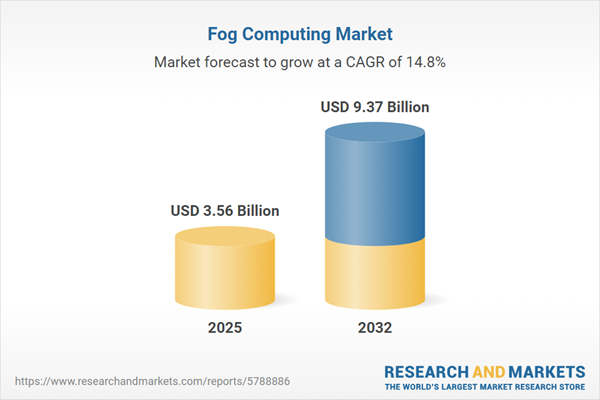Speak directly to the analyst to clarify any post sales queries you may have.
Fog computing is shaping the next phase of enterprise technology by closing the distance between on-premises data processing and centralized cloud systems. Designed for real-time responsiveness, robust security, and scalable digital operations, fog computing offers a resilient foundation for businesses navigating increasingly complex and distributed digital environments.
Market Snapshot: Fog Computing Market Growth and Opportunities
The global fog computing market is experiencing substantial growth, expanding from USD 3.10 billion in 2024 to USD 3.56 billion by 2025, with projections reaching USD 9.37 billion in 2032 at a CAGR of 14.83%. Enterprises across industries are adopting fog-enabled analytics to facilitate real-time data integration and drive digital transformation. This momentum underscores fog computing’s value as a core technological strategy, meeting expanding automation requirements and adapting to evolving operational landscapes in diverse business sectors.
Scope & Segmentation: Strategic Insights into the Fog Computing Ecosystem
This report provides senior decision-makers with actionable clarity on the fog computing landscape, supporting strategic alignment with regulatory compliance, growth, and advanced security needs. The evolving ecosystem is increasingly impacting technology investments, strategic planning, and operational models, particularly in industries where asset distribution or regulatory oversight is stringent.
- Component: Hardware offerings—such as edge sensors and advanced networking equipment—support powerful on-site data processing and continuous connectivity. Software and service components, including analytics platforms, cybersecurity tools, consulting, and integration services, deliver bespoke, scalable deployments to align with a wide range of enterprise objectives.
- Deployment Model: Hybrid, private, and public fog computing models deliver deployment flexibility, enabling organizations to meet both compliance mandates and maintain granular operational control in complex digital settings.
- End User: Sectors such as energy, utilities, healthcare, manufacturing, retail, and transportation leverage fog computing to optimize distributed asset management, enhance automation, improve customer engagement, and strengthen supply chain operations.
- Application: Critical use cases comprise content delivery optimization, real-time IoT analytics, device and asset management, decentralized data processing, and improved data tracking. These use cases empower enterprises to derive actionable insights closer to where data originates.
- Organization Size: Both large enterprises and small-to-medium businesses are integrating fog solutions, tailoring adoption based on existing digital capabilities, propensity for risk, and strategic initiatives.
- Region: Major uptake occurs in the Americas, EMEA, and Asia-Pacific. Markets in China, India, and Japan exhibit accelerated growth due to focused investment in digital infrastructure and regulatory frameworks that support new technology deployment.
- Leading Companies: Prominent industry players—Cisco Systems, IBM, Microsoft, Intel, Hewlett Packard Enterprise, Dell Technologies, Huawei, Fujitsu, Hitachi, and ADLINK Technology—address broad enterprise requirements with extensive fog-enabled solutions portfolios.
Fog Computing: Key Takeaways for Decision-Makers
- Proximity-based data processing through fog computing reduces analytics latency and streamlines response times, enhancing operational flexibility in distributed business models.
- Decentralized architectures help companies maintain uptime and operational continuity, especially where resources are dispersed or where process disruptions must be minimized.
- Integration of artificial intelligence and machine learning in fog environments enriches compliance automation and workflow efficiency, which is especially relevant in tightly regulated industries.
- Multi-layered security, including robust encryption and zero-trust controls, allows enterprises to safeguard sensitive data and adapt to shifting compliance requirements across physical and digital sites.
- Strategic partnerships with technology vendors and service providers enable organizations to navigate deployment complexities, address compliance intricacies, and stay ahead of regulatory trends.
- Real-time applications and resilient data management practices are gaining traction in sectors like healthcare and manufacturing as infrastructure, compliance, and data handling requirements mature regionally.
Tariff Impact: Strategic Supply Chain Considerations
- Tariff developments, notably in the United States, are driving organizations to diversify hardware sourcing, foster local manufacturing, and build agile, resilient supply chains in response to geopolitical and economic uncertainty.
- Adoption of software-driven deployments and wider use of edge virtualization decreases dependence on single-source vendors, bolstering adaptability to trade policy shifts and global market changes.
- Managed service providers and consulting partners are investing in expanded offerings to support enterprise clients in navigating regulatory complexity and managing end-to-end supply chain risks.
Methodology & Data Sources
This analysis integrates primary industry research, regulatory and technical assessments, as well as direct interviews and scenario modeling with market leaders to equip decision-makers with reliable, relevant insights across the fog computing value chain.
Why This Report Matters
- Provides an evidence-based framework to guide high-impact investment and digital transformation initiatives in alignment with enterprise demands.
- Enables business leaders to proactively manage regulatory change and supply chain risks using practical tools and scenario planning.
- Delivers rigorous, actionable methodologies for benchmarking technology vendors and capturing opportunities as digital infrastructure evolves.
Conclusion
Fog computing empowers enterprises to enhance analytics capabilities, drive more agile operations, and support continuous digital innovation across diverse environments and market conditions.
Additional Product Information:
- Purchase of this report includes 1 year online access with quarterly updates.
- This report can be updated on request. Please contact our Customer Experience team using the Ask a Question widget on our website.
Table of Contents
3. Executive Summary
4. Market Overview
7. Cumulative Impact of Artificial Intelligence 2025
List of Figures
Companies Mentioned
The companies profiled in this Fog Computing market report include:- Cisco Systems, Inc.
- International Business Machines Corporation
- Microsoft Corporation
- Intel Corporation
- Hewlett Packard Enterprise Company
- Dell Technologies Inc.
- Huawei Technologies Co., Ltd.
- Fujitsu Limited
- Hitachi, Ltd.
- ADLINK Technology Inc.
Table Information
| Report Attribute | Details |
|---|---|
| No. of Pages | 188 |
| Published | November 2025 |
| Forecast Period | 2025 - 2032 |
| Estimated Market Value ( USD | $ 3.56 Billion |
| Forecasted Market Value ( USD | $ 9.37 Billion |
| Compound Annual Growth Rate | 14.8% |
| Regions Covered | Global |
| No. of Companies Mentioned | 11 |









